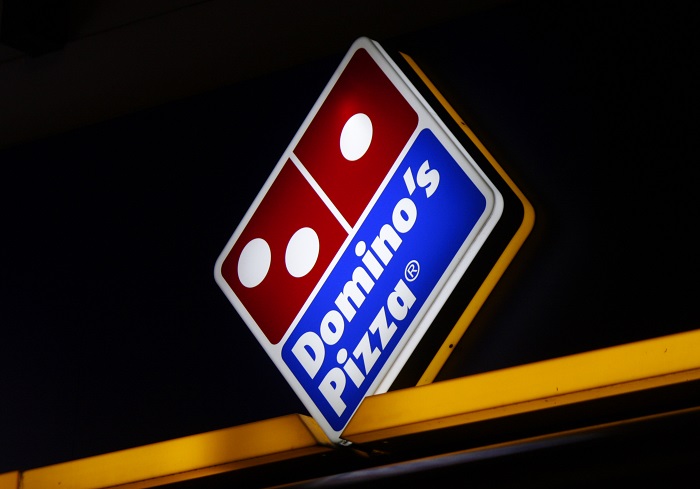
Fast casual pizza chain Domino’s announced Q4 earnings as well as final numbers for 2017 on Tuesday (Feb. 20). Net income was $93.3 million (compared to last year’s $72.7 million) and earnings per share were at $2.09 (compared to $1.48 per share in 2016).
The chain fell short of analysts’ Q4 sales estimates, ticking in at $891.5 million in total quarterly revenues – analysts were predicting $906.4 million. As a result, Domino’s stocks were $210.66 on Tuesday morning, down $10.08 or 4.56 percent.
On the company’s Q4 earnings call, executives said that general and administrative costs had increased by $1.6 million in the fourth quarter versus the prior year quarter, driven primarily by planned investments in eCommerce, point of sale systems, and the teams that support those systems.
Among 2017’s expenditures were the growth of the company’s AnyWare suite of ordering platforms. Executives reported a strong year for digital loyalty, with voice and Alexa ordering methods driving more traffic. The company also tested self-driving delivery vehicles toward the end of the year.
“As we discussed at our Investor Day last month, we are the technology disruptors,” said outgoing CEO J. Patrick Doyle, who is slated to be replaced as CEO by Domino’s International president Richard Allison in July.
Doyle added the company’s role as tech disruptor is “shown by the technology fee increase.”
Admittedly, said CFO Jeff Lawrence, “we didn’t do as well versus our plan this Q4 compared to Q4 back in 2016. So, your year-over-year comparison there also led to lower overall expense, but most importantly, the strategic investments are on track and we continue to invest in those areas.”
The company invested more than $90 million in capital expenditures for the full year with a heavy focus on tech capabilities. Its philosophy is that tech should be developed in-house, because third-party technology is available to anyone and therefore, the firm says, cannot be treated as a differentiator.
“If it continues to be available to everybody then almost by definition it is a commodity,” said Doyle. “Only if you acquired it and then got everybody else off of that technology would there be an opportunity to really start to turn that into competitive advantage.”
In terms of delivery, Doyle added, “We have built real competitive advantage over the years by doing it ourselves. The only way to build long-term competitive advantage is to do something yourself.” That is why the firm will not allow anyone other than Domino’s to deliver Domino’s pizza.
“If you use a third-party,” Doyle said, “you are basically deciding this is something where we are not going to build competitive advantage. And if you do it yourself, the only reason to do it yourself is because you think you can do it better than you could do by accessing third-parties.”
Delivery, however, is not a new expense for Domino’s, nor is it an exorbitant one: the company said doing it in-house has actually been much more economical than going through aggregators like Grubhub, at least for now – although such economics are always subject to change.
Doyle said demand and supply for delivery seem to be growing at about the same rate and Domino’s has not yet seen a substantial impact to its business because of activity elsewhere in the space.
In other metrics, international store growth continued its 96-quarter, 24-year positive trajectory for stores open at least one year, which is a measure the industry uses to reflect a restaurant’s unit growth.
Domestically, restaurants open for the same amount of time logged their 27th consecutive quarter of growth.
Notably, the pizza giant opened 441 stores last quarter and closed only nine across domestic company-owned stores, domestic franchise stores, and international stores. Taking a bird’s eye view of 2017, that number becomes 1,045 stores opened by the company worldwide in 2017. The company now has 14,800 stores in more than 85 markets.
Yet analysts did note a deceleration in stocks over a two-year period, questioning whether some elements may be softening within the U.S. market in particular. Domino’s said it still feels good about the numbers and expects things to even out in Q1.
As for a definite softening in the Asia-Pacific region, the chain said it had changed leadership in Japan and honed in on value to resolve issues there.
Analysts wondered whether franchisees could be more proactive to avoid such softening in the first place, rather than hearing about the company’s plans to “fix” or “correct” issues in relevant markets.
The company said the challenges in Asia-Pacific were “just a misfire” and the region would bounce back as the U.K. and India had done earlier in the year when faced with a similar softening.
“You are always going to do your best with the research that you have and make as logical decisions as you can, but every once in a while you just don’t get it right,” Doyle said. “We have got phenomenal master franchisees who understands their local markets and the dynamics there better than we’re ever going to and most of the time… they do a pretty good job. Every once in a while they are going to miss.”